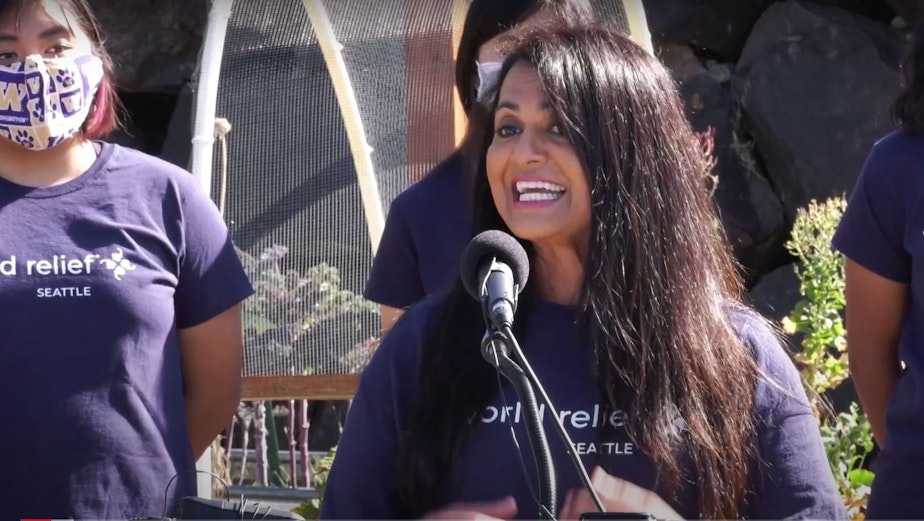‘Fierce urgency’ on climate needed, county exec says
King County aims to cut climate pollution in half this decade and prioritize the needs of communities of color as it does so.
“We must act with fierce urgency,” King County Executive Dow Constantine said as he proposed a climate action plan to combat what he called “the greatest threat to humanity.”
A viral pandemic and racial unrest have pushed the climate threat out of the headlines for most of 2020. Yet the pollution-fueled unraveling of our climate continues.
“The pandemic, I hope, is not with us forever, but climate change is upon us, and it’s long term,” said Tahmina Martelly with the refugee-resettlement group World Relief Seattle. “We have to address it now, and it’s urgent.”

Constantine announced the new climate plan in Kent at a former parking lot that World Relief Seattle has turned into a community garden.
People from 23 countries now grow food there, Martelly said.
Sponsored
By soaking up rainwater that used to run immediately off parking-lot asphalt, the garden plots also help tackle two problems expected to worsen in a hotter, stormier climate: urban flooding and stormwater carrying pollution into Puget Sound.
“Climate change is a threat multiplier to social issues,” environmental-justice activist Jill Mangaliman with Seattle-based Got Green said. “Communities already live in food deserts and the most polluted neighborhoods. With climate change, it will only get worse.”
“It's really important to make sure that those most impacted by climate change are centered in the discussion,” Dinah Wilson with the Kent Cultural Diversity Initiative Group.
Wilson’s group and others representing communities of color played a central role in shaping the plan, which commits the county to collaborating with “frontline” communities as well as reducing emissions and preparing for climate impacts countywide.
“We want to increase training,” Wilson said. “We want to increase green jobs.”
Sponsored
Constantine’s proposed plan would commit the county to reduce emissions 50% below 2007 levels by 2030 and 80% by 2050.
Halving climate-harming emissions in a decade is half as ambitious a target as outlined in Seattle’s “green new deal” law, passed last year, which commits the city to eliminating carbon pollution this decade.
Constantine said the county’s new plan would “build on the momentum” of its 2015 climate plan.
Yet neither King County nor Seattle has come close to meeting the targets of their previous climate plans.
King County has aimed since 2008 to reduce emissions 25% by this year.
Sponsored
But emissions fell just 1.2% from 2007 to 2017, the most recent year the county has data available.
Emissions per person dropped 11%, which means that even if King County’s population hadn’t grown at all, the county would have achieved less than half its planned 25% reduction in countywide pollution.
As it was, the per-person reductions have been almost entirely undone by the Seattle area’s surging population.
“King County can’t accomplish these goals on its own,” Matt Kuharic, the county’s climate change specialist, said in an email. “Partnership with businesses, nongovernmental organizations, other governments, utilities, community leaders, and county residents is essential to success. Meeting these types of targets is a shared responsibility – we will only succeed by working together!”
“Touting procedural successes while completely failing to achieve tangible goals is emblematic of the lack of seriousness by politicians who claim to be most concerned about climate change,” Todd Myers with the free-market-oriented Washington Policy Center said in an email.
Sponsored
The city of Seattle has an 18-year track record of promising national leadership on climate and failing to deliver on its promised emission reductions.
In 2020, Seattle’s efforts to fight climate change have gotten stuck in the dense traffic of competing crises.
- A pandemic-driven budget crunch and hiring freeze have prevented the hiring of a coordinator for the city’s “green new deal” programs.
- The city has also “largely paused” its halting efforts to advance Mayor Jenny Durkan’s April 2018 proposal to toll downtown traffic. No public meetings have been held or detailed proposals presented in more than two years.
- In August, the Seattle City Council postponed for one year the heating-oil tax it had passed in October. The tax, now scheduled to begin September 2021, would fund low-income residents’ conversions to energy-efficient electric heat pumps.
Sponsored
“We had to delay the oil tax that we were doing just because of who it would hit during this crisis,” Durkan told KUOW's The Record.
Durkan said the city was continuing to push forward on climate change.
“It’s harder in this atmosphere of the triple things that we’re facing, but we don’t want to lose ground,” she said.
The Seattle Department of Transportation turned 20 miles of city streets into “Stay Healthy Streets” for safe exercise. Those will remain blocked off to most car traffic—the city’s biggest source of carbon pollution—after other pandemic restrictions go away.
“Creating better ways for Seattle residents to get around without a personal vehicle remains a top climate strategy for the City,” Sara Wysocki with the city’s Office of Sustainability and Environment said in an email.
Pandemic public-health measures chopped highway traffic in King County by half this spring. Traffic volumes on Interstates 5 and 405 have since rebounded to within 5-14% of their pre-pandemic levels, according to Washington state Department of Transportation data.
The King County Council is expected to hold public hearings on the new climate action plan this fall.




